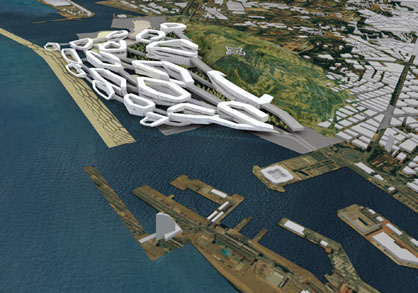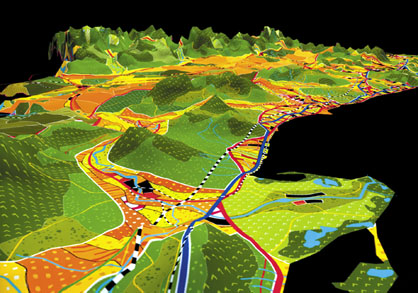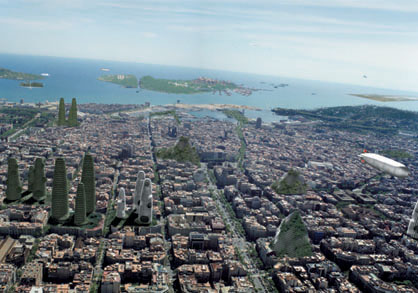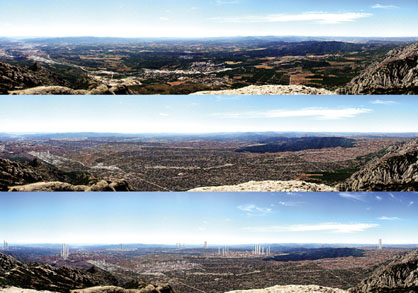|
|
| home > files |
| Multi-cities,
geo-urbanities, hyper-territories Manuel Gausa |
| HiperCatalunya
è il nome di un progetto di ricerca e analisi basato su uno studio territoriale
a scala regionale, promosso dalla Generalitat de Catalunya, diretto
da Metapolis
e realizzato nell'Iaac (Istituto di Architettura Avanzata di Catalunya).
HiperCatalunya è nato con l'obiettivo di proporre una prospettiva "avanzata"
del territorio contemporaneo e di riconoscerne e valorizzarne le potenzialità.
Di "interrogare" -come scrivono i suoi autori- il territorio per far
emergere le sue capacità e i suoi punti deboli, nel tentativo di superare
i tradizionali meccanismi di analisi territoriale. Hipercatalunya, cui
sono stati invitati a partecipare in forma di azione collettiva 25 gruppi
di architettura di diversi Paesi -tra cui Eduardo Arroyo, Cloud 9, Roldán+Berengué,
Federico Soriano, Duncan Lewis, Vicente Guallart and Willy Muller, FOA,
MVRDV, Roche & DSV, Actar Arquitectura, IaN+ e West8- tende a dare impulso
a interpretazioni aperte all'interazione tra il panorama esistente e
l'immaginabile. Tutto questo in forma coerente con una dimensione innovatrice
della cultura contemporanea, suscettibile di promuovere nuovi spazi
corrispondenti a rinnovati modi di vita. Il lavoro prodotto ha originato
una grande quantità di progetti e di materiale di ricerca, che è stato
presentato lo scorso 17 luglio nei locali del Museo de Arte Contemporanea
di Barcellona, dove rimarrà in esposizione fino al 26 ottobre 2003.
ARCH'IT propone ai lettori il testo di Manuel Gausa pubblicato nel catalogo
(Actar, Iaac Metápolis, Hipercatalunya, research territories, 896 pagine,
1400 illustrazioni) e le conclusioni del
progetto scritte in forma di manifesto da parte di Manuel Gausa, Vicente
Guallart, Willy Müller, i tre direttori di Metapolis. |
||||
| Day
after day we see how those functional elements, more or less aggressive,
more or less attractive or attractors, that formerly seemed to be localized
in that artificial organism that we called the "city," today rapidly
invade this other environment, theoretically more "rural" or "natural,"
that we once called "territory." The city –or at least many of its traditional
manifestations– today tends to "explode," scattering over a distance,
and this explosion appears to impact –with greater or lesser force and
density– our surroundings, thus affirming this increasingly ambivalent,
heterogeneous and dynamic state of progressively entropic growths. Seen in satellite views, the irregular patches of most current "urban-territorial" structures do not appear very different, in effect, from many other dynamic structures frequent in nature. They are not, strictly speaking, forms (stable) but formations (evolutionary): open trajectories that –like the societies linked within them– fluctuate, change, shudder and alter, therefore manifesting an uncertain character: their movements synthesize, in effect, infinite interactive processes of dynamics and distortions, systems and contingencies, global logics and local situations, growing in complexity –and in diversity– just as they grow in and deal simultaneously with mobility, communication and exchanges between multiple levels of information.  WMA_Willy Müller arquitectos. Ports no continentals. Structures that translate this multi-layered nature of developments are no longer only "formal" but above all "relational," occurring in more elastic frameworks of exchange generated within –and among– diverse settings (territories, flows, places, cultures, etc.), near and distant, real and virtual. We find ourselves disconcerted by the heterodoxy and unprecedented nature of this recent manifestation of environments that reveal themselves to be increasingly discontinuous, mutable, irregular and that, in situations of inertia or short-sightedness, tend towards the accumulation of events not only individualized but also unorchestrated and opportunist. Nonetheless, this irregular, plural, mongrel, and definitively open –unfinished– dimension of current metaurban settings can, oriented in a positive manner, become an exciting offering of diverse situations and experiences, able to favor more qualitative and symbiotic relations –and combinations– between multiple strata and events: settings of crossing conceived in a virtual hyper-place –or "place of places"– that must be discovered, prognosticated, assessed and/or revitalized.  Actar Arquitectura. Catalonia Land Grid. The traditional tools of the urban discipline would seem to yield, thus, to this more polyhedral and open state of contemporary space, which requires not models ("old" or "new"), but criteria: criteria capable of detecting strategic and potential situations in the system and of inducing in them qualitative reactions. Combining strategic levels of action, orienting and identifying this new multiple dimension of current systems of territorial relation which would struggle between different dimensions, states and scales, between that which is urban and territorial, between that which is physical and virtual, between that which is natural and artificial, and which could be associated with what some of us have defined as "multi-cities" or "geo-urbanities" in our approach to the ambiguous limits of these realities, posited beyond the traditional metropolitan areas and the eternal urban/rural dichotomies. The concept of a "city of cities" in reference to the metropolitan realm would define a concept that, despite the critical voices heard at the time, seems to have found favor among theoreticians and experts, adopted, even, as a possible official "slogan" for post-post-Olympic Barcelona. However, this officially proclaimed "city of cities" tends to continue orienting itself, still, towards a "neo-traditional" notion of the urban setting understood as a large structure of agglomeration rather than as an authentic relational "infrastructure:" a landscape of "patterns" rather than a pattern of "landscapes," a large conglomerate rather than a mesh.  Actar Arquitectura. Infrastructures (+ energy-generating nodes). Nevertheless, the new "networked" nature of the structures of current development permits the fostering of a more irregular and elastic state of the city and the territory: the old expansive forms of "metropolitan" accumulation thus yield to more polyhedral and discontinuous complexes that combine old and new "centers," attractor nuclei and intermediate nuclei, networks of connection and spaces of relation in a new type of structures of exchange, more complex and flexible, among "associated identities" rather than among "subordinate entities." Structures capable of working concertedly or in coordination in order to compensate a necessary and increasingly differential distribution of growth and added value and its associated environmental "actions" and "corrections," fostering new –not necessarily homogeneous or isotropic– urban models of deliberate definition, and therefore, new qualitative (more "irregular" and "selective") strategies of territorial planning. To speak of a multi-city would thus be an allusion to a setting in which mobility, interconnection and interscalarity would have as much weight as would have, in turn, landscape and "interplaces," intersections and nodes, growths and discontinuities. In speaking of a hyperterritory, we would mean this multi-layered dimension of a new setting of simultaneities in which to identify different strategic levels of reading, recognition and venturing, whose greatest capacity would lie in its potential degree of combination. But also of "linkage," among data and phenomena, situations and demands, latencies and emergences: key questions... and latent questions.  Vicente Guallart: Reinformed nature and environments. Based on these sorts of considerations we might posit a number of questions regarding the "multiple," strategic and territorial dimension of the current Catalonia-Barcelona binomial. What sort of possible common structure or "contract" should this future "metapolitan" setting of plural exchange be oriented towards that would interconnect growths and landscapes, axes and foci of development, channels of growth and environmental corridors, in a single "geo-strategic" logic of interaction? With what criteria of intervention, preservation and articulation should the current multi-Barcelona concert itself with the new development of Girona and Tarragona and its relation with the north and south coasts? What role would be played in this polyfocal structure (GI-BAR-TAR) by the current intermediate urban nuclei (Vilanova, Vilafranca, Igualada, Manresa, Vic, Granollers, Mataró, etc.), and how could we define in this possible "meshed matrix" an effective articulation of development, nature and landscape? What possible articulating role would be played in this discontinuous conurbation by the A7/B30 highway as a large central corridor? What sort of "linkage" would be required for the large logistical potential of the Lleida-Tàrrega-Cervera "axis" and its entire area of internal influence? What new functional state would have to be assumed by the mountainous spaces, as nature reserve and active territory at the same time? How do we approach a functional definition of infrastructures and their possible combination with natural energy systems and productive flow? Beyond the old models of urban extension and industrial areas, how should cities grow in accordance with a new environmental sensibility and a notion of habitat as a relational landscape? In what manner should the old existing fabrics be re-informed to ensure the necessary urban "reimplosions?" With what criteria should both parameters –growth and restructuring– be brought together to ensure qualitative action in a territory potentially capable of accommodating production, leisure and knowledge, based on the correct strengthening of its infrastructures? From what new creative, technological and territorial ambition must we face the challenges of the information society and its translation into new settings of exchange?  IaaC. Growth and recycling. Given all of the above, it is not a question of positing, once again, the classic polemic between "diffuse" and "compact" models, but rather of promoting a possible "interlinked" –connecting– model with which to concert strategic agreements capable of superseding the traditional definitions of "city" and "territory" in new geo-urban surroundings (and systems), but capable as well of superseding the old concepts of hierarchical development, zoned growth, and mono-functional regulation that the old models of urban planning and classification made us accustomed to, and of replacing the old linear and one-dimensional models with new multi-layered, programmatically n-dimensional definitions. We refer, then, to a new flexible logic with which to conceive authentic "territories of crossing," posited based on this "multi" and "multifaceted" state characteristic of virtual, diverse and diversified "places of places," rather than on any desire for a hypothetical, essential, cohesive and single "ideal place." It is these criteria which would involve not only a logical amortization of existing territorial values and assets but also, above all, a determined and constant will to re-inform –from the surveying and innovation of our environment, as well as from advanced management of the territory itself– able to express our cultural, spatial and technological paradigms. Cities and countries have been cut loose, today, into a new sort of network and networked drift, and their greater or lesser capacity for progress depends on their identification as polarizers and distributors of qualitative information (and, thus, of creative as well as productive information). Otherwise, their development stalls, enters into dynamics of inertia and routine and tends towards self-decadence, that is, to a lesser or greater degree, towards subsidiary dependence. Manuel Gausa |
[31aug2003] | |||
| hiCat.
A DOUBLE DECALOGUE A - POTENTIALS 1. PREPARE THE FUTURE. A circa-2020 reality requires circa-2002 research. To prepare the future is to orient the present, to probe its "territories of limit". hiCat engages in an advanced survey of today’s territory in order to "import" tomorrow. 2. TRANSVERSALIZE KNOWLEDGE. Approaching –planning– the territory is a question not of trade but of research. Anticipating the future requires transverse –multidisciplinary– visions. hiCat defends a new type of "interactive methodology" in the approach to new scenarios for the future. 3. PRIORITIZE INTERACTION. A complex system is an interactive system. hiCat ventures an interaction posited as an exchange between disciplines, scales, cultures and settings. Mobility, communication and exchange at all levels favor a gradually dynamic (and not linear) manifestation of processes, which implies working with more open logics: systems, structures, devices. hiCat is an approach to this open condition of new systems of territorial relation. 4. CELEBRATE COMPLEXITY. A complex reality is a multiple reality. Simultaneous. Multifaceted. hiCat ventures this multi-layered dimension of reality and of the territory/ies of simultaneity inherent therein. 5. MAKE THE TERRITORY SPEAK. A territory can be interrogated. Not only described. Analyzed from the viewpoint of action. To interrogate the territory is to draw out its potentials and latencies. hiCat asks questions of the territory. Rather than disorienting doubts, oriented questions. "On/off valves" open to future evolutions. 6. WORK ON DIVERSE SCALES. Scale is not a measure but a system of relation. hiCat expresses the "multi-scalar" dimension of an n-dimensional Catalonia: state, country, region... multi-city. Local definition and global projection. This capacity for translation entails a vision more strategic than formalist: sparking processes rather than designing events. Relations rather than figurations. Operative criteria rather than formulative models. 7. RETHINK IDENTITY/IES. Identity is identification. Differential action. Capacity for meaning. hiCat ventures an ambitious will to create possible singular references in plural environments. Not essentialities (univocal) but meanings (cosmopolitan). 8. PROMOTE INNOVATION. To innovate is to reinform, to apply new generating information to a system. A will to progress from the social, cultural and technological viewpoint must be accompanied by a more qualitative –and culturally demanding– definition of our space and our habitats. To innovate is also to venture. To know the "operative limits" of the system in order to foster creation and the incorporation of new instructions (and new codes) of use. 9. DEFEND DIVERSITY. To accept the diversity of our environment is to prioritize heterogeneity over homogeneity, irregularity over regularity, discontinuity over continuity. hiCat posits a diverse ambition in the territory, appropriate to our society and our times. 10. CONNECT DISCONTINUITY. To balance the territory is not to homogenize it. hiCat ventures the discontinuous dimension of an interconnected territory. A large meta-urban geography of places and "interplaces." 11. CREATE NETWORKS, ARTICULATE PLACES. To create networks is not to create reticules. To work with irregular "meshes" of connection is not to work with isotropic grids. hiCat opts for an elastic system of interconnections at once capable of interlacing spaces and orienting them. With a broader conception of landscape and infrastructures, as interactive systems, the territory can be posited as a polyhedral structure of articulated places and "interplaces." Neither a monocompact, agglomerative model nor a diffuse, "splattered" model: an interlaced model capable of weaving implosive operations, of urban restructuring, of expansive operations, of territorial development. hiCat defends this open –flexible and braided– conception of the overall system. 12. GENERATE MIXING, FAVOR CROSSING. To foster mixing is to favor blending, exchange, crossing. Also impurity. And hybridization; social, cultural, functional, programmatic, structural, typological, etc. hiCat defends this hybrid condition of the new devices of relation. 13. FOSTER A NEW "NATURAL CONTRACT." The old primarily urban vision –continue the city– of traditional urban planning gives way to a new sensitivity open to a creative interaction with nature (geography, landscape, etc.). Environments rather than objects. hiCat emphasizes this encounter with a nature understood not as an antinome of architecture but as a work material approached from a possible new sustainable epic. 14. MULTIPLY REALITY. A re-impulsive will from the environment seeks neither to "continue" reality (=), nor to reject it (-), nor even formalize it (+), but to multiply it (x): working with simultaneous levels of crossed bits of information such that building edifices might mean creating landscapes or building private spaces might mean generating public surfaces. hiCat defends this correlating logic of codes, classifications and categories, appropriate to our times. 15. FOSTER UNINHIBITED VISIONS (AND ACTIONS). A vision sensitive to the potentials (and assets) of reality and, at the same time, open to the benefits of positive creation and change tends to move between the real and the possible, favoring more spontaneous and uninhibited interplay in and with reality, that is, an action free of formal or formalist apriorisms. hiCat seeks to affirm this capacity to produce new operative systems, at once pragmatic and imaginative. B - CONCRETIONS 1. GLOCAL CATALONIA. Catalonia can affirm its local identity only through a global ambition. Bolstering its foreign relations and favoring, as well, the emergence of its own references of international dimension. This possible glocal state (meaningful and cosmopolitan) is what allows the securing of a positive in-out exchange and, at the same time, the possibility of exercising leadership in the field of research and knowledge. 2. THREEFOLD CATALONIA. A scheme of Catalonia may be drawn based on several synthetic trinomials: a triangle, three sides that point to a threefold state: natural, artificial and digital; three functional areas of horizontal N-S expansion (the Coast, the Interior and the Mountains) and three vertical binomials of E-W connection; three multi-urban axes: GI-BAR-TAR, VIGUMARRERSOT and LLEITARCER; and, in this project, three basic layers (geography and logistics, networks and systems, habitats and cultures). 3. CATALONIA: GEO-URBAN. Catalonia manifests itself as a territory between scales and dimensions: a manageable and diversified territory that can be seen as a large dispersed multi-city or as a new, interurban type of geography of relations: a networked geo-urbanity. 4. NETWORKED CATALONIA. Catalonia’s geographic, infrastructural and demographic structure, the particular disposition of its corridors, mountain ranges and plains, allows us to conceive, from different functional parameters (economic, productive, landscape, heritage), an at once specialized and interconnected mobility. To build roads is to build links, differential networks. The territory can be understood as a large matrix of places and "interplaces," confirmed identities and new emergent identities. 5. INFRASTRUCTURAL CATALONIA. With its particular multi-nodal definition of large infrastructural systems and their relative proximity, Catalonia’s infrastructural definition can now be seen not only as territorially-compressive meshes (shortening distances in new relation times) but also as generating agents of new economic and energy resources. New lands for the production of uses and/or the collection of energy. Infrastructures as new territories of opportunity. 6. INNOVATIVE CATALONIA. Catalonia must move towards better territorial distribution of its infrastructures of research, training and knowledge: an impulse to training, on active campuses of social exchange, and a redefinition of academic and R+D structures. If, on the other hand, the territory is the expression of the construction of the environment itself, hiCat signifies this innovative dimension oriented towards the construction of new types of more stimulating and imaginative mixed environments: residential, formative, productive, etc. 7. RECREATIONAL AND CULTURED CATALONIA. With the assessment of a qualitative infrastructural network, related to a strategic reconsideration of current health, tourist, cultural, service, leisure, heritage and/or training structures, Catalonia can be seen as a possible territory of mixtures tending to favor links between leisure, culture and knowledge. Mixed settings for a leisure that is formative... and active. 8. RELATIONAL CATALONIA. The particular social, cultural and infrastructural conditions of Catalonia favor a relational will among cultures, populations and generations. To prioritize social hybridization and foster new plural environments, bringing together experience and restlessness, active and passive societies, host and guest populations, implies favoring new settings of real exchange. 9. HYBRID CATALONIA. A Catalonia of crossings is a Catalonia tending to foster new hybrid codes, coupling together old dual categories: natural and artificial, urban and geographic, landscape and architecture, public and private, ordinary and extraordinary, local and global... New hybrid natures for new mixed environments. 10. NATURFICIAL CATALONIA. To develop does not mean to grow, to grow does not mean to occupy. An active understanding of the environment entails combining sustainable actions of development, associated with a new synaesthetic relation with the landscape, and operations of recycling and restructuring, associated with a structural redefinition of the old existing patterns. Extending the landscape and imploding architecture. Landscape and heritage as materials sensitive to a reactive intervention. 11. REACTIVE CATALONIA. A reaction in the environment is a relational action (relate and activate). A reactive logic processes bits of information from immediate and global environments and reformulates them, inducing processes sensitive to the context and at the same time capable of transcending it, leading it towards new real and virtual states. It is not a matter of continuing reality or simply transforming it, but of reinterpreting it strategically and qualitatively. 12. N-DIMENSIONAL CATALONIA. A multi-layered comprehension of reality requires a multi-layered compression of its functional activities, uses and programs. To conceive the territory as a scenario of crossings and of simultaneities means a qualification of the land no longer based on one-dimensional zoning (urban land, non-urban land, residential zones, industrial zones, green zones, etc.), but an n-dimensional qualification able to combine percentages and strata of use and programming in new hybrid devices. 13. RECYCLED AND REINFORMED CATALONIA The notion of recycling introduces the need to invent new answers for those materials that are now rendered obsolete. Stopping processes of wear and maladjustment by means of global actions of restructuring and redefinition capable of fostering new relations between the construction of our environment and changing surroundings. Recycling means starting a new cultural, physical, economic and social cycle in the city. To work between the universe of virtual information and the world of physical reinformation means fostering the design of spaces sensitive to an interaction among phenomena, processes and contexts. Between city and nature, construction and environment, flows and energies, localities, networks, etc. 14. SUSTAINABLE CATALONIA. In a world limited in natural resources and deficient in absorption of waste, the concept of sustainability implies a new economic, technological, ethical as well as aesthetic awareness, sensitive to possible synergy between potentials and efforts, of the existence of a life cycle of materials encompassing everything from their production under the most optimum conditions to their reuse and exploitation. This same attitude is extendable to the city and to the territory, in which existing structures and spaces, as well as actions or new interventions, can renourish themselves in order to maximize their respective potentials. 15. FOUNDATIONAL CATALONIA. Catalonia does not necessarily have to be small. Its territory is not large, but it does have the capacity to reinvent or manipulate its own geography and, therefore, to found new places, close or distant, interior or exterior, reclaimed or acquired. Catalonia can develop a slow epic that expands its territories through new settings of growth and/or recycling. |
||||
|
>
BANCHINI: TERRITORI DI RICERCA |
||||
|
ARCH'IT
books consiglia Manuel Gausa, Vicente Guallart, Willy Muller "Hicat: Hipercatalunya Research Territories" Actar, 2004 pp800, acquista il volume online a prezzo scontato! |
|
Per
qualsiasi comunicazione laboratorio
|